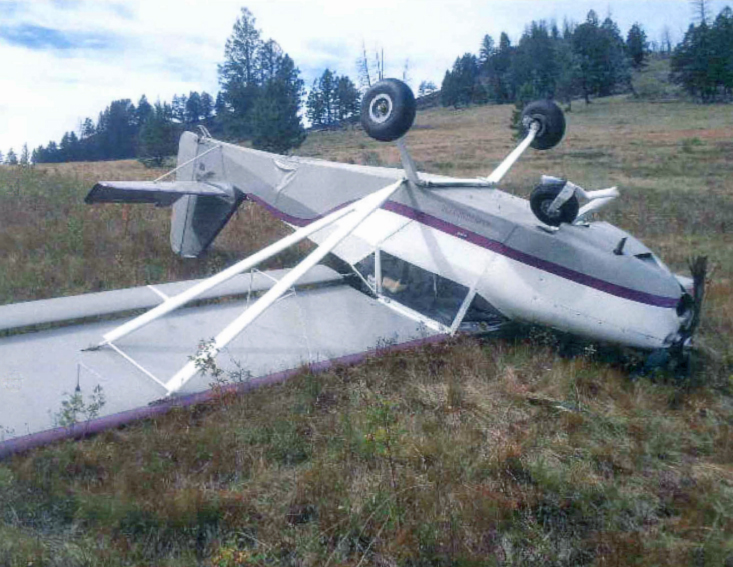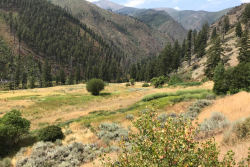Lawsuit challenges unlawful expansion of aircraft landing areas in River of No Return Wilderness
June 2023: Wilderness Watch, Great Old Broads for Wilderness, Friends of the Bitterroot, and Friends of the Clearwater filed a lawsuit against the Payette National Forest in central Idaho on June 20, 2023 challenging the Forest Service’s unlawful decisions to establish and maintain four locations in the Frank Church-River of No Return Wilderness for aircraft landings and to permit hobby pilots to use these sites for motorized recreation. The four plaintiffs are represented by Advocates for the West.
At more than 2.3 million acres, the Frank Church-River of No Return Wilderness is the largest contiguous federally managed Wilderness in the United States outside of Alaska, providing important habitat for a wide variety of native wildlife species susceptible to disruption by aircraft flying low over—and landing within—the Wilderness. The Central Idaho Wilderness Act, which designated the River of No Return Wilderness in 1980, grandfathered a select few airstrips that were already in public use for wilderness access to remote areas.
Yet, four locations now popularized by hobby airplane pilots were not among the lawful, grandfathered locations. These four unlawful landing sites occur in the Big Creek drainage, a popular area for hikers, backpackers, and river rafters. The Forest Service’s own documents show the agency recognized back in 1980 that these former dirt airstrips, once used to reach private property, were abandoned, unmaintained, and not subject to public access. Thus, in 1982, the agency and the state of Idaho agreed that these four sites in the River of No Return Wilderness should revert back to their natural state. Three lawful public-access airstrips on National Forest land and one on state land already exist within the Big Creek watershed, over an area only about 30 miles from east to west.
The Forest Service has long bowed to pressure from aviators pushing the agency to open the Big Creek Four to unlimited use by recreational pilots. Years ago, rather than state clearly its determination that these sites were closed to all landings, the agency labeled them “emergency use only,” a phrase that pilots have long chosen to ignore, instead treating the sites as open for public use.
As the complaint filed today explains, “[t]he Forest Service has never documented or substantiated its need to make these four locations available for emergency landings. Each of the Big Creek Four landing areas sits within several miles of an open public or private airstrip.” The agency lacks any documentation of true emergency landings at the Big Creek Four over the past 40 years, the complaint alleges. Instead, these spots have “more reliably served to create emergencies as pilots wrecked while attempting to land at these locations for fun.”
The area’s wilderness quality continues to suffer from the ongoing and increasing noise and intrusion, with the illicit landing areas being used for multi-airplane rendezvouses, practice “touch and go” landings, airstrip “bagging” in which recreational pilots see how many landings at different locations they can rack up, and even overnight airplane camping. The Forest Service has documented that a person in the Big Creek area—and the wildlife there—can often encounter up to 30 low-flying airplanes in a single day.
“The Wilderness Act makes clear that the Forest Service must protect the Wilderness character of the River of No Return, and it makes particularly clear that aircraft landings and other motorized activity are allowed only under narrowly defined conditions,” said George Nickas, Wilderness Watch executive director. “The Big Creek Four airstrips were not in regular use at the time of Wilderness designation in 1980, and they have never been lawful airstrips open to any public use. Establishing four more landing strips in the Big Creek drainage just chokes this spectacular area with incessant airplane traffic."
For years, the agency has been turning a blind eye to the growing popularity of illegal landings. In response to recent pressure, the Forest Service changed its official tune to further facilitate the aircraft landings. A 2018 directive from the Regional Forester dictated a new policy of allowing the public to land at the Big Creek Four even in non-emergency situations. It also called for the preparation of formal maintenance plans in consultation with Idaho, which the agency completed in 2022. Last summer, Forest Service staff went out to one of the Big Creek Four locations and began cutting down large trees to clear a better pathway for aircraft to land. Similar development is planned for the future.
“That’s why we’re taking the Forest Service to court. Opening these locations to public aircraft landings has no basis in the law, and it degrades the wilderness in direct contravention of the Forest Service’s wilderness protection mandate,” explained Dana Johnson, Wilderness Watch’s policy director based in Moscow, Idaho. “Our lawsuit will show how the Forest Service has ignored the facts in its record, acted contrary to the Wilderness Act and the Central Idaho Wilderness Act, and capitulated to recreational flying demand without disclosing and analyzing the environmental impact it would cause.”
Additional Resources:
• Read the full press release from our coalition
• Read the complaint
• FAQ: Frank Church-River of No Return Wilderness airstrip lawsuit
• Our 2018 letter to the Forest Service urging them to close these unlawful landing areas
News Articles:
• Lawsuit: Frank Church wilderness airstrips fly in face of law (Missoulian)
• Ignored by feds, aircraft continued 'illegal landings' in Idaho wilderness, lawsuit says (Idaho Statesman)
• Advocates sue Forest Service over Frank Church wilderness airstrips (Idaho Report)
BACKGROUND:
 In 2018, Wilderness Watch and other groups have sent the Chief of the Forest Service a letter urging him to permanently close four backcountry airstrips located in the Big Creek drainage within the Frank Church-River of No Return Wilderness in Idaho. The Simonds, Vines Ranch, Dewey Moore, and Mile Hi airstrips were not in regular use at the time of wilderness designation through the Central Idaho Wilderness Act in 1980, and they should have been closed permanently decades ago. Instead, the agency has kept them open under “emergency use only,” bowing to pressure from aviators and the Idaho Congressional delegation who are now pushing the Forest Service to open the strips to unlimited use by recreational pilots.
In 2018, Wilderness Watch and other groups have sent the Chief of the Forest Service a letter urging him to permanently close four backcountry airstrips located in the Big Creek drainage within the Frank Church-River of No Return Wilderness in Idaho. The Simonds, Vines Ranch, Dewey Moore, and Mile Hi airstrips were not in regular use at the time of wilderness designation through the Central Idaho Wilderness Act in 1980, and they should have been closed permanently decades ago. Instead, the agency has kept them open under “emergency use only,” bowing to pressure from aviators and the Idaho Congressional delegation who are now pushing the Forest Service to open the strips to unlimited use by recreational pilots.
The area’s wilderness quality continues to suffer from the ongoing and increasing noise and intrusion, with the airstrips being used for multi-airplane rendezvouses, practice “touch and go” landings, and airstrip “bagging.” In 1982, the Forest Service put forth a plan to let the four airstrips revert back to their natural state. It’s long past time for this to happen.
• Read the letter to the Forest Service
Photos: Top—Dewey-Moore landing area in the Frank Church-River of No Return Wilderness as photographed by Wilderness Watch in 2022. Bottom—Plane crash in the Mile Hi landing area by U.S. Forest Service.
Contact Us
Wilderness Watch
P.O. Box 9175
Missoula, MT 59807
P: 406.542.2048
Press Inquiries: 406.542.2048 x2
E: wild@wildernesswatch.org
Minneapolis, MN Office
2833 43rd Avenue South
Minneapolis, MN 55406
P: 612.201.9266
Moscow, ID Office
P.O. Box 9765
Moscow, ID 83843

